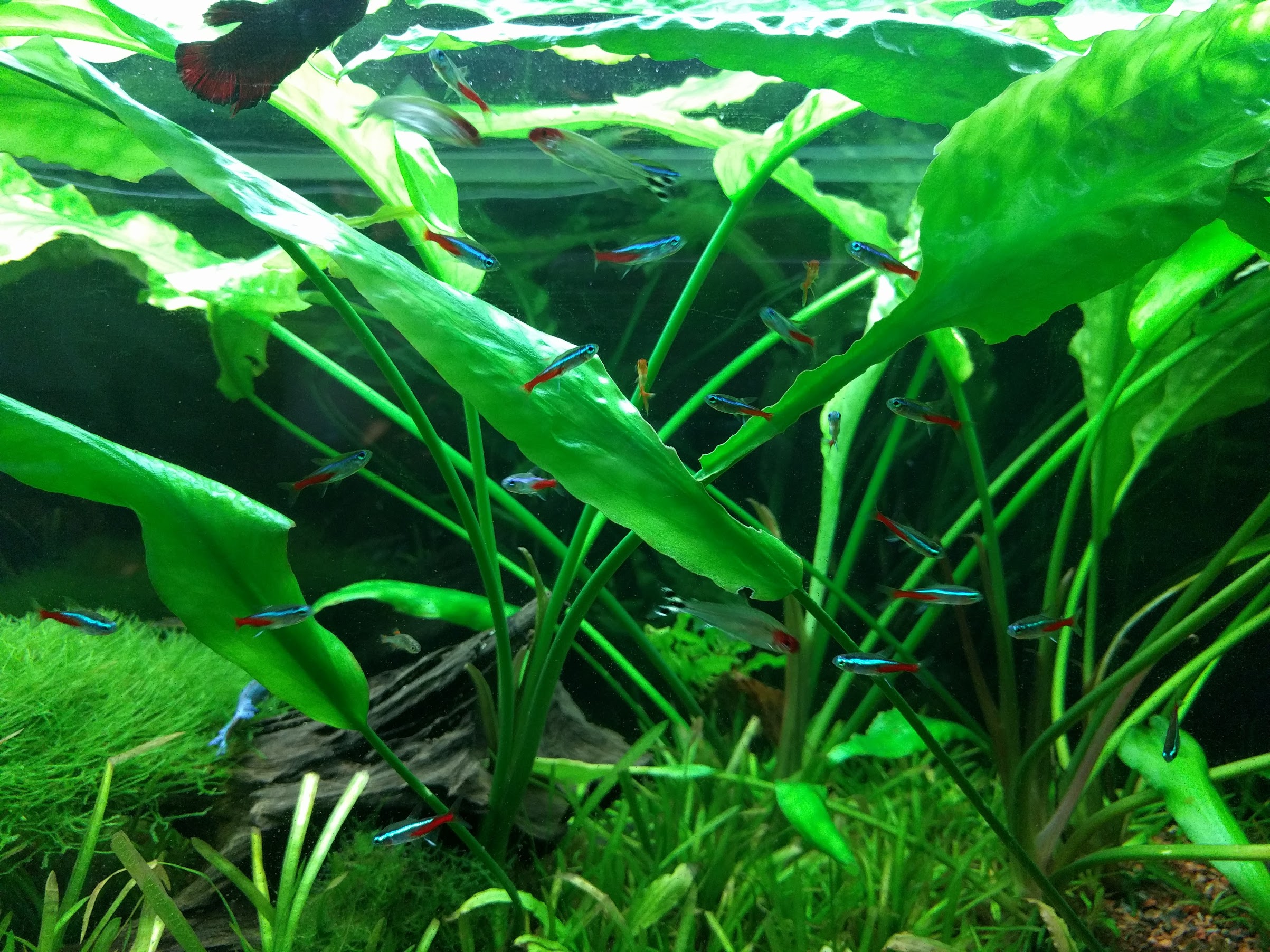A planted aquarium may sound a little bit confusing but the best choice for betta sorority tanks, especially for beginners. Anyone can easily set up a 10-gallon tank with gravel and cheap decorations for a single betta; but if you want many female bettas in the same tank, it will not be that easy. Planted tanks are the best solution for betta sorority aquariums. Planted tanks have a special set of necessities, many of which can be quite tricky to get exactly right. Mostly, we will discuss planted aquariums, not too much about betta fishes on this article.
 That said, planted aquariums are extremely beautiful when done correctly. And also provides a lot of hiding spots for female betta fishes. There is something simply amazing about an aquarium loaded with luscious green plants and colorful betta swimming between them. It’s almost like a piece of the Amazon River right in your living.
That said, planted aquariums are extremely beautiful when done correctly. And also provides a lot of hiding spots for female betta fishes. There is something simply amazing about an aquarium loaded with luscious green plants and colorful betta swimming between them. It’s almost like a piece of the Amazon River right in your living.
Within this guide, we will take you through the step-by-step process of setting up a planted tank. We will cover all of the important steps and equipment, so bookmark this for future use!
A few things you may need:
You may need to pick up a few pieces of equipment before setting up a planted aquarium. Here are a few things you may well need:

LED lighting: I always recommend the Beamswork DA 6500. Finnex is also a great brand. Most of the Finnex LED lights are made specifically for planted tanks.
Substrate: Choosing a substrate is something that a number of people hassle with. I would recommend either CaribSea Eco-Complete or Seachem Flourite.
Heater: An ideal tank necessity. I recommend the EHEIM Jager Aquarium Thermostat Heater.
Filtration System: The kind of filter you want really varies depending on your setup. If you’re setting up a tank greater than 40 gallons or so, you probably want to go with a canister filter. For smaller setups, a hang on the back unit is usually fine.
And of course, plants: Here are main types of plants
Carpeting Plants: What do their name suggest? Basically these plants to exactly that; carpet for your tank floor, which is a beautiful green carpet. Carpeting plants like Java Moss tend to grow quickly and easily, attaching to substrate, rocks, and driftwood at it grows.
Foreground Plants: They are purposely intended to be put in the very front of the tank. They tend to stay relatively short, so your view of the back of the tank won’t be obstructed. Species such as Anubias Nana and Pygmy Swords offer fantastic fill.
Mid-Ground Plants: They should be rooted near the center of the tank and are slightly taller than any foreground plants. They tend to be a little thicker and fill out more of the tank, so they give the aquarium a nice “full” feeling.
Background Plants: These are your main piece showstoppers. Plants like Amazon Swords are large, thick, and tend to be the main attraction. They are usually placed at the very rear of the tank as to not obstruct the view.
Test kit: This is an absolute must when preparing a planted aquarium. The API Freshwater Master Test Kit is the best accurate on the market.
Step 1: The Substrate
Selecting a substrate for a non-planted tank is really easy. Just pick any kind of gravel and you’re good to go. So why doesn’t this help planted tanks? The answer is nice and easy; plants require nutrients to survive. Gravel, which is pretty simple to clean, does not carry out any nutrients well. Which is not enough to support most aquatic plants.
Kinds Of Planted Aquarium Substrate
So we know that plain gravel probably isn’t an optimal choice. Fortunately, there are some types of substrate that help with nutrients and promote excellent plant growth! We suggested a bit about our selected preferences earlier in this article, but now we focus more and dive into a little more depth:
Flourite: This substrate is unique because it doesn’t naturally contain any nutrients, but is absorbs nutrients from the water very efficiently. If you choose to use this substrate, it is greatly recommended to add on a few root tabs (which are tiny discs that have and hold tons of nutrients and then “leach” it into the substrate). Flourite will suck the nutrients well, which is then used by your aquatic plants as a food source. I recommend Seachem Flourite for an amazingly sleek look.
All-in-One Substrates: These substrates use actually a “mix” of several different types of substrate and are pre-packed with tons of nutrients (so there is no need for root tabs!). If you’re looking for some serious plant growth, all-in-one substrates can’t really be defeated. I highly recommend CaribSea Eco-Complete.
Note: If you choose to use a substrate that is already pre-packed with nutrients, be certain that there isn’t any fish inside of the tank when you add it. The spike of nutrients can cause high levels of ammonia for the first few days, which can easily be deadly for fish.
Laying the Substrate
Plant substrates may cloud up the entire tank unless laid down correctly. This can be one of the highest frustrating parts of setting up a planted aquarium.
Before you put into the aquarium, ensure to rinse the substrate. Use a five-gallon bucket and rinse it until the water runs relatively clear. Nowadays, a lot of substrates claim that a rinse is unnecessary but I usually perform it anyways.
Next, apply at least 3 to 4 inches of the substrate into your aquarium tank. A lot of people like to cover it off with some gravel to keep everything together better, but this is completely optional (sand is also a good option, but make sure to only work with aquarium sand). It is important to know that even the best-washed substrate on the planet will cause a mess if you don’t fill the tank carefully, so add water little by little!
A great tip to avoid a ton of clouding is to place a plate (any old dinner plate should do) on top of your newly-laid substrate and dump the non-chlorinated water on top of the plate instead of straight into the substrate. This will prevent it from mixing up the soil/gravel and save you a huge headache. Do not rush this step!
Step 2: Lighting
Getting your hands on a good lighting fixture is vital when setting up a planted aquarium The basic fluorescent bulbs that come with most fish tanks simply won’t cut it.
A light fixture is definitely something you don’t want to skimp on; buying discount light fixtures will probably cost you more in the long run and can even be a fire hazard. Luckily, good lighting is can actually be pretty cheap.
Here are some of our most referred light fixtures for planted tanks:
Beamswork DA 6500K— Definitely one the inexpensive light fixture on amazon. It does a great job at plant growth.
Hagen Fluval Plant Bluetooth Nano LED Aquarium Light (15 Watt)— If you can pay a little more I definitely recommend this one.
Finnex LED lights — The Planted+ is a little on the pricier side, but you are definitely spending for quality. This unit has tons of extra features, such as sunrise and starry night simulators, customizable color channels, and storm effects. Although it is not required for plant health, these outcomes can really help with adding life to your tank. Additionally, the Planted+ is popular for showing off vivid colors, especially in red plants.
Feeling out a Light Cycle
When setting up a planted aquarium, it is essential to know that no two tanks are alike. There is no magic light cycle or a certain amount of hours you need to keep your lights on. That said, I start out keeping my lights on somewhere between 8-10 hours a day.
If I want a bit more development for my own plants, I would boost the light cycle by 1-2 hours. If I notice any growth in algae, I would then decrease it back a bit.
Some aquarium tank plants would be in good condition with 10 hour days while others may like a little more. It is important to sense out your tank and try some different cycles to get good growth and prevent algae.
Step 3: Filtration
Choosing your filtration may not be among the most fun part of installing a planted aquarium, but it’s important. That said, I believe that the majority of people tend to overthink their filtration setups. My advice is pretty simple:
Tanks under 50 Gallons: Smaller planted fish tanks under 50 gallons (especially novice tanks) are completely fine with hang on back filtration. Though not as powerful as their canister versions, but these units are hassle-free, user-friendly, and function well. I recommend the AquaClear Power Filter.
Tanks 50+ Gallons: Larger tanks over 50 gallons are suited for canister filters. Canister filters can process a lot more water, which could be a necessity for hard-to-keep plants. I recommend the EHEIM 2213.
Important note: Whatever type of filtration system you choose, ensure to remove any activated carbon. Carbon removes the nutrients that your plants need to flourish.
Step 4: Adding Plants
Among the frustrating parts of setting an aquarium is looking at an empty tank for weeks while it cycles.
Currently, you may contemplate and ask, “Is it important to cycle my aquarium(tank) before putting any plants?” Luckily, the answer is no! As a matter of fact, live plants can actually help quicken the entire cycling process. Ensure you still monitor the cycling process carefully and never add fish until ammonia and nitrites are entirely undetected.
As a beginner, it is significant, to begin with, easy-to-keep plants. These plants won’t require any specific dosing or upkeep other than some occasional trimming, clicking photos will open Amazon website for you to see the prices:
Caring for your plants.
There is more to putting together a planted aquarium than throwing some plants in a tank. A planted aquarium requires a certain level of maintenance to stay healthy. Here are some tips to maintain a healthy lifestyle for your beloved plants:
Bi-weekly water adjustments are a definite necessity— Why? Well, they are beneficial for several reasons. Nitrate (expectantly with no ammonia and/or nitrite) tend to appear and develop in your aquarium tank over time. Unluckily, enough filtration can only get nitrate levels dropping so far. Bi-weekly water adjustments help decrease nitrates down to their safe levels. Additionally, water changes help replenish beneficial trace-elements that boost plant growth.
Keep temperatures stable— There are loads of opinions and studies about the perfect temperature for planted tanks (I suggest somewhere between 75-78 degrees). In reality, keeping your water temperature stable is far more important than the actual temperature level. A good quality heater is a must. I use the EHEIM Jager Aquarium Thermostat Heater and I am happy for many years.
Trim your plants occasionally— Don’t misunderstand me. Letting your plants grow out and fill up the tank is amazing to watch and you should definitely let this happen. Avoid creating any excessive growth for your plants, especially tall plants. They would grow large, and also create too much shade, killing plants below them by restricting access to light. Trim your plants every now and then to make sure they’re not blocking other plants below.
Fertilizing your Plants. I recommend you to buy one of the trimming sets. See photo on left. The clicking photo will open the Amazon page for the set.
Low-tech setups usually don’t require any sort of dosing or exclusive additions in terms of trace elements. A few fish should do this trick to keep your plants happy. But, just like gardens, setting up a planted fish tank sometimes requires fertilization. Here are the two main types of fertilizers is you decide you want explosive plant growth:
Substrate Fertilizers— Substrate fertilizers are placed underneath the substrate. These are especially effective when used with substrates such as Flourite due to its high ability to absorb nutrients. Plants use the nutrients gradually, so nothing gets to waste.
Liquid Fertilizers— Liquid fertilizers are most effective for plants that don’t grow roots in the substrate, including Java Moss. Because of the fact that they are not able to suck up any nutrients from within the substrate, they pull the desired nutrients from the water. Be careful with liquid fertilizers; they tend to promote algae growth if dosed in high quantities.
Remind yourself, if you intend to keep any easy plants in a low-light setup, fertilizing your planted aquarium could be unneeded. I would recommend feeling out your tank for a while to see how growth is before dosing.
Step 5: Adding Fish.
Regardless if you own a planted aquarium or not, adding fish is always a big milestone. Please do not hesitate to take your time for this step.
Although plants sometimes help speed up the cycling process, it still isn’t an instant process (usually takes 2-3 weeks). Ammonia and Nitrites should not be present when you add any live fish in your aquarium tank. Pick up an API Master Test Kit and test often before you add your betta fish!
Once your planted aquarium is completely cycled, it is time to add your female betta fishes. It is not advised to add other community fishes with a betta. You may add some Corydoras and angelfishes if you really want to.
Corydoras: Cory Catfish are among the most peaceful and chill freshwater fish available. They are the ideal community fish and could potentially eat a variety of foods. If I could at least only suggest one fish, these types of fishes would take the spot. Cory catfishes tend to be happiest in groups of 5 or more.
Angelfish: One of the most popular freshwater fish, Angelfish make great inhabitants for any community fish tank. They are gorgeous, (nearly) peaceful, and tend to leave the aquarium plants be.















